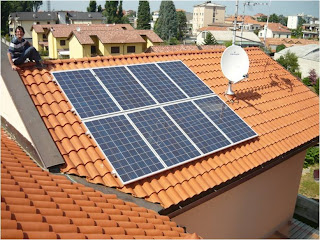PV: Here is the first challenge As promised in the first post, here's the first challenge. Now we prove with facts, because there is only one reason why the world is not worth to install a fotovolitaico if you have a roof exposed correctly (South, South East, South West).
This post is intended as a lesson on photovoltaics. I just try to share with readers who have not yet too familiar with the topic, some basic concepts for the sole purpose of stimulating your imagination! If at the end of reading this post think you wanted to pursue and would like some clarification, please do not hesitate to contact me. Although only one new plant will be installed thanks to my help, I will be happy to have done something for your money, our consciousness and our dear old planet.
Thanks to a state incentive that is received by
GSE (Electrical Services Manager) , in un periodo di circa 10 anni (possono diventare 5 o 6 in Sicilia, Calabria, Puglia etc.) si può ripagare un mutuo a tasso agevolato per installare un impianto capace di fornire tutta l'energia necessaria ad una abitazione. Alla fine dei 10 anni, si continuerà a ricevere l'incentivo per altri 10 (infatti l'incentivo dura 20 anni). Quindi anche se non si dispone di un centesimo da investire, basta trovare una delle tantissime banche convenzionate per chiedere un mutuo. Nei primi 10 anni aggiungendo ai soldi ricevuti dal GSE quelli che si sarebbero spesi per l'energia che normalmente avremmo pagato all'ENEL si ottiene quanto basta per pagare il mutuo. Nei successivi 10 anni ci si mette in tasca una somma identica a quella che nel primo decennio si è returned to the bank. Apart from the economic aspect, it is important to note that throughout the period of 20 years, all the energy consumed is generated in the home for free (the loan used to repay the facility but the sun is free!) From the sun.
Here are details on the incentive that is received by the GSE
:
- 0.431Euro per KWh produced
- 0,130 Euro (approximately) for each kWh that you enter in the ENEL network
The management of the energy generated and consumed and fed into the grid is set by the GSE with the metering mode
. The metering can be summarized as follows: the PV system produces
energy when the sun is present. Of course during the spring / summer production is greater than the winter / autumn. The system must be sized so that within 12 months and the production of the plant equals or slightly exceeds the amount of energy consumed. Just take the bills a year and see how many kWh are consumed in a long time (1 or more years). Obviously it is still connected to the ENEL network that acts as a "battery" providing energy during the night and when that produced by the plant are lower than necessary. During the hours of production, the energy is used directly from the house and / or placed on the network. For example, if the plant is producing 1.4Kw of instantaneous power, the house will have a total power given by the sum of 3kW counter Enel and the energy produced. So in a sunny day, having a implant 2Kwp, you have more than 4kW of power. You can then go to the washing machine and dishwasher together without coming off the counter.
Warning: NOT 'THE WAY YOU NEED A PLANT BY JUST BECAUSE 3KW' YOUR COUNTER AND '3kW.
Here is a practical example. I will show you the data on the system in production since August 4, 2009 at my house.
Data:
- energy consumed in a year about 1600 KWh
- 1.84KWp system installed (kW peak) consists of 8 panels 230Wp
- occupied area 15 sqm
- estimated annual production around 2000 KWh
- installation cost 12,000 Euro
- ten-year installment loan 108 Euro / month
- incentive for the estimated annual production 930 Euro
- recessed estimated annual energy input to the network 188 Euro
- estimated annual energy expenditure charged 219 Euro
- average expenditure in the absence of PV 347 Euro
The total annual estimated balance is (930 +188 -219 +347) 1247 Euro which is to be compared with spending on the mortgage (1316Euro), shows how the whole operation pays for itself. In fact, according to this estimate nell'arco dei 12 mesi ci rimetterò circa 60 Euro! Tutto questo perchè ho voluto scegliere un mutuo di 10 anni anzichè 12 o 15. E' ovvio che anche se per 10 anni spenderò qualche decina di Euro all'anno in più di quanto avrei speso per pagare le bollette ENEL, poi verrò ripagato dal fatto che mi resteranno 10 anni di incentivo senza mutuo da pagare!
Trovate qui di seguito tutti i dettagli dei conti economici del mio impianto. Sottolineo che i dati fino a Dicembre 2009 sono reali. Invece quelli da Gennaio a luglio 2010 sono stimati.
Nota: per vedere l'immagine a grandezza naturale, basta cliccarci sopra.


